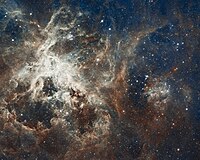NASA launches exoplanet-hunting satellite TESS
Saturday, April 21, 2018

Image: NASA.
On Wednesday at 6:51 p.m. local time (2251 UTC), a SpaceX Falcon 9 rocket launched from Cape Canaveral Air Force Base in Florida, United States, carrying, as a payload for the US National Aeronautics and Space Administration (NASA), the Transiting Exoplanet Survey Satellite (TESS). NASA designed TESS to search for exoplanets circling stars mostly within 300 light-years of the Sun.
Officially a NASA Astrophysics Explorer mission, much of the TESS program is to be run from the Massachusetts Institute of Technology's (MIT) Kavli Institute for Astrophysics and Space Research in cooperation with the Goddard Space Flight Center. "One of the biggest questions in exoplanet exploration is: If an astronomer finds a planet in a star's habitable zone, will it be interesting from a biologist's point of view?" TESS principal investigator George Ricker told the press, "We expect TESS will discover a number of planets whose atmospheric compositions, which hold potential clues to the presence of life, could be precisely measured by future observers."
A little more than an hour after launch, NASA and SpaceX teams announced the satellite was up and functioning and had deployed its solar panels. Most launches have a roughly two-hour period during which the mission can be executed, but this one had a window of only thirty seconds because this satellite must use the Moon's gravity to reach the desired orbit.
TESS is slated to enter a high orbit distinct from the geosynchronous orbits used by many other satellites. TESS instrument scientist Joel Villasenor, also of MIT, explained, "The Moon and the satellite are in a sort of dance. The Moon pulls the satellite on one side, and by the time TESS completes one orbit, the Moon is on the other side tugging in the opposite direction. The overall effect is the Moon's pull is evened out, and it's a very stable configuration over many years. Nobody's done this before, and I suspect other programs will try to use this orbit later on."
If all goes according to plan, TESS will circle the Earth for 60 days to establish its 13.7-day orbit and test its machinery before beginning its mission: using its four cameras to analyze stars for decreases in brightness that may be caused by a planet passing between us and them, a technique called the transit method. TESS's launch comes just as the Kepler space telescope, launched into orbit around the Sun 2009, is about to run out of fuel. Scientists used Kepler to identify at least over 2300, perhaps over 4500 planets and gather data on stars and black holes. TESS is designed to cover 400 times as much of the sky as Kepler, and is capable of viewing 85% of the sky. Scientists expect it to find 1500 planets during its two-year mission, 300 Earth-like, but believe it may find many more.
Because TESS's cameras can cover a wide range of radiant energy, including infrared, scientists believe it may be able to detect planets orbiting red dwarf stars, which scientists consider likely to host rocky, Earth-like planets with the right mass for an atmosphere and the right temperature to host liquid water, a range called the habitable zone.
The data collected by TESS are to be publicly accessible so anyone who wishes may participate in the search. NASA plans to process the data, about 27 gigabytes collected per day, using a supercomputer called Pleiades.
The original schedule had launch at 6:32 p.m. on Monday evening but it was postponed so the SpaceX team could perform more guidance navigation control tests before launch.
SpaceX is a private company that has partnered with NASA before on such missions as resupplying the International Space Station.
Sources
- Ashley Strickland. "NASA's planet-hunting satellite TESS launches" — CNN, April 18, 2018
- Paul Brinkmann. "SpaceX hits triple success with launch of NASA's planet-hunter TESS" — Orlando Sentinel, April 18, 2018
- Ashley Strickland. "Launch of NASA's planet-hunting satellite TESS postponed" — CNN, April 16, 2018
- Ian Semple. "Nasa to launch Tess on hunt for 20,000 new worlds" — The Guardian, April 15, 2018
- Bob Granath. "Successful Liftoff Begins SpaceX Dragon Mission to Space Station" — NASA, April 2, 2018
External links
- "MIT TESS Science Office" — Massachusetts Institute of Technology, April 21, 2018 (date of access)


